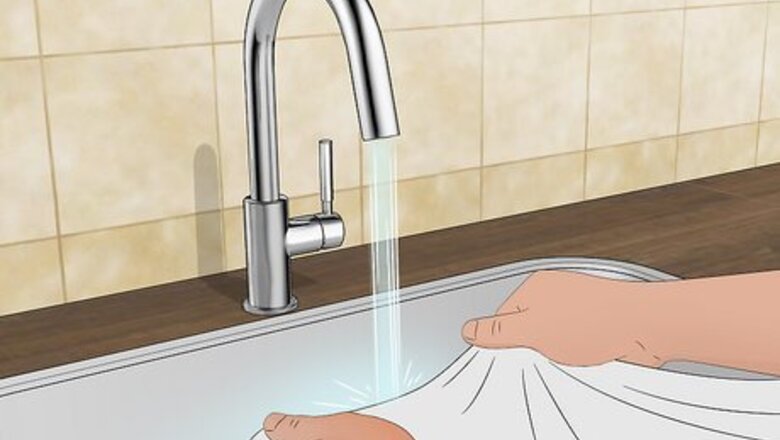
views
- Rinse out the urine spots and blot them dry before soaking them in oxygen bleach.
- Coat your clothes in a white vinegar solution. Then, apply baking soda to the stains before putting them through the laundry and air-drying them.
- Clean your clothes a second time by washing them with an enzyme detergent that can destroy urine odors for good.
Rinse the spot with cool water.
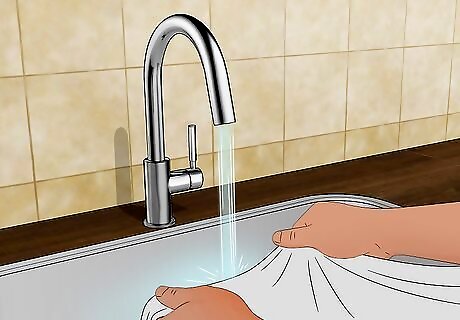
Get as much urine out as you can with water first. Take the affected garment to the sink and run a stream of cool water over the stain for a few minutes. Before treating the fabric for odor, it’s important to pretreat it by washing away as much of the urine as possible. Cat urine sets into fabric easily otherwise. Be sure you’re using cool water (not hot or warm) because heat can set odors into the fabric and make them even harder to get out.
Blot the fabric with a paper towel.
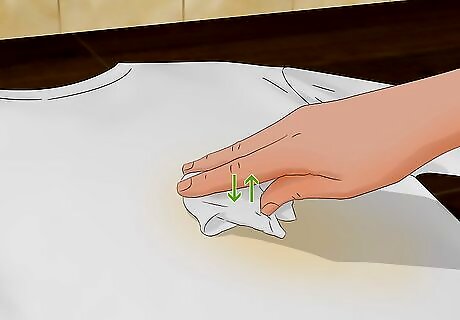
Soak up remaining urine by blotting the wet spot, not rubbing. Rubbing the stain will just set it deeper into your clothing. Instead, use paper towels to dab at the stain until it’s as dry as possible. Rinsing and blotting your clothes while the stain is fresh gives you a better chance of removing the odor during the first wash!
Soak the item in oxygen bleach.
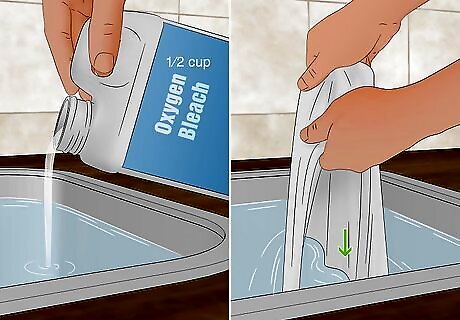
Oxygen bleach can break down odors and germs in fabric. Fill a sink with water, add a ⁄2 cup (120 mL) of oxygen bleach, and mix it in thoroughly. Then, place the stained clothing in the sink and let it soak in the bleach. If the clothing is colored, let it sit for at least one hour; if it's white, soak it for up to four hours. Oxygen bleach is often sold as Oxiclean, Vanish, or simply oxygen bleach. Avoid using chlorine bleach. When combined with ammonia in urine, it can create harmful gases.
Coat the stain with a vinegar solution.
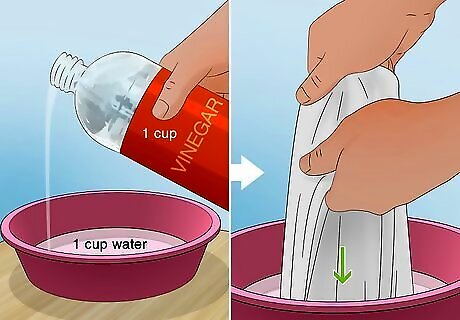
Vinegar is an acidic product that neutralizes the alkalinity of the urine. Essentially, the acid in vinegar kills the urine bacteria, so it doesn’t smell anymore. Create a vinegar solution by mixing 1 cup (240 mL) of water with 1 cup (240 mL) of white vinegar. Coat your fabric with the solution and let it sit and soak in for a few minutes before moving to the next step. White vinegar is the most effective cleaner because it won’t stain any fabric. You can use vinegar to eliminate many odors, not just cat urine! If a piece of clothing or fabric smells bad, treat it with white vinegar.
Apply baking soda to the stained area.
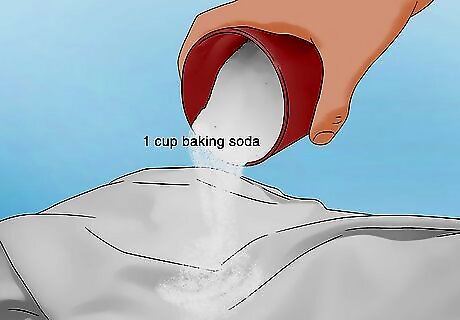
Baking soda can absorb odor and make it come out of clothing easier. Cover the urine stains with baking soda; you likely won’t need more than 1 cup (237 g) to prep a garment for washing. While baking soda is optional, it’s a useful addition to the cleaning process because it works with vinegar to neutralize the cat urine smell.
Machine wash each item without detergent.
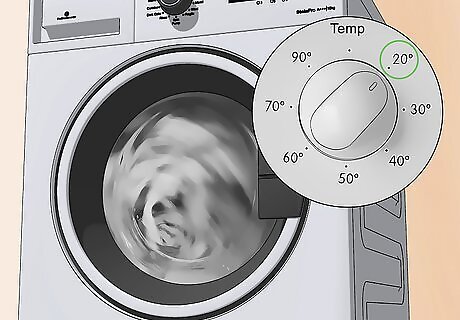
Washing with vinegar and baking soda helps neutralize odor. Toss your stained clothing in the washing machine and wash it using a cool or cold setting—warm or hot water will set in the urine odor. It’s okay to wash more than 1 urine-stained item if you need to, but don’t wash a full load all at once; this allows each garment to get as clean as possible. You’ll use detergent on the second wash (this process involves 2 washes total). However, it’s best to let the vinegar and baking soda do their jobs on the first wash. Try not to mix urine-stained clothing with other clothes in the same load. Cat urine odor is powerful and can spread to your other clothes too.
Let the clothing air dry.

Air drying is more effective than heat-drying them in a machine. Hang up your clothes to dry. Either dry your garments indoors, which will take 24 to 36 hours, or leave them outside to dry for about 3 hours. Either way, it’s important to air-dry instead of using a clothes dryer; the heat from the dryer will make the urine smell permanent and ruin your clothing.
Re-wash the clothes with enzyme detergent.
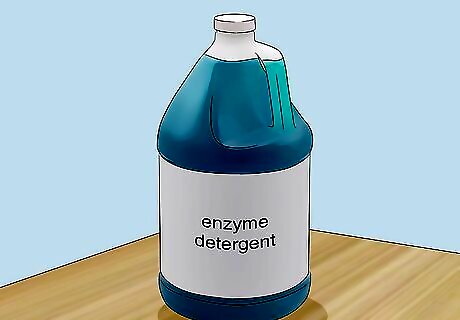
Enzyme detergents can fight and dissolve organic-based stains like urine. After the initial wash, purchase an enzyme detergent, which is designed to fight stains at a much lower temperature than traditional detergents. Then, run the garment through the laundry again, setting the washing machine to a cool or cold water cycle. Most detergents labeled as cold-water detergents contain enzymes. However, read the ingredients on the detergent container just to be sure. If possible, choose a detergent that lists protease as an active enzyme ingredient. It's the best at removing urine stains.
Wash your clothes multiple times if necessary.
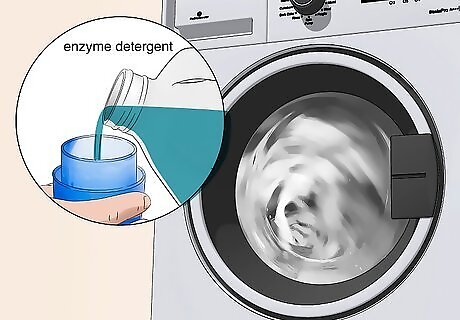
The stain might take a few washes to remove, depending on its severity. Don’t give up if your clothing comes out of the wash still faintly smelling of cat urine! Remember: it’s a strong scent and doesn’t come out easily if the urine dries before you can wash it, but multiple cycles in the washing machine can do the trick. Wash your garments with enzyme detergent until the smell is gone. Vinegar, baking soda, and oxygen bleach are all great for pre-treating fabric, but enzyme detergent gets rid of smells for good—which is why it’s such an important part of the process.
Check your cat’s health if they have frequent accidents.
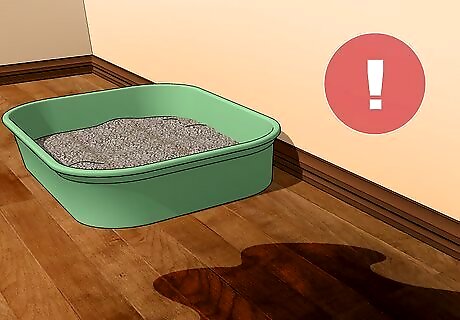
Peeing outside the litter box can signify stress or a medical issue. Ensure your cat is happy and healthy (and prevent future accidents outside the litter box) by taking your cat to the vet. A veterinarian can verify whether there are any problems and give your cat the medical treatment they need to get them peeing in the litter box once again. Possible issues include: Your cat might have a urinary tract problem causing them to avoid the litter box, or they might feel pain in their joints that makes climbing into a box difficult. Bathroom difficulties could just be a part of old age. Cat dementia and cognitive dysfunction in elderly cats often makes them do their business outside the litter box. Changes like a new family member, a new pet, or even just moving the litter box can stress your cat out. Reduce your cat’s stress by rewarding them with treats and attention when they use the litter box correctly. Check the litter box! It might be as simple as your cat not wanting to use a dirty litter box, or not liking the litter in it. Clean the litter box more often and try new kinds of litter to see if your cat responds positively.


















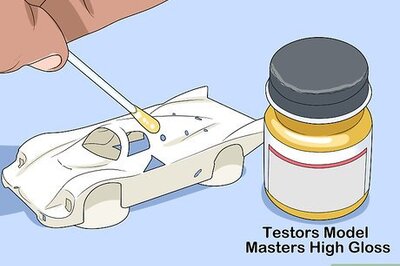
Comments
0 comment